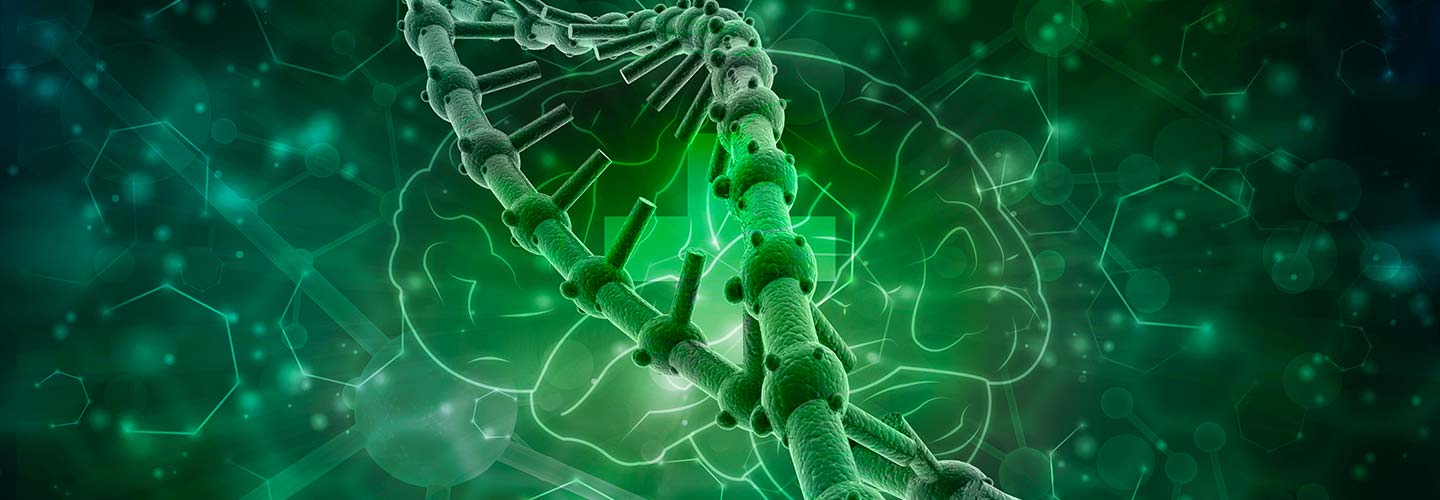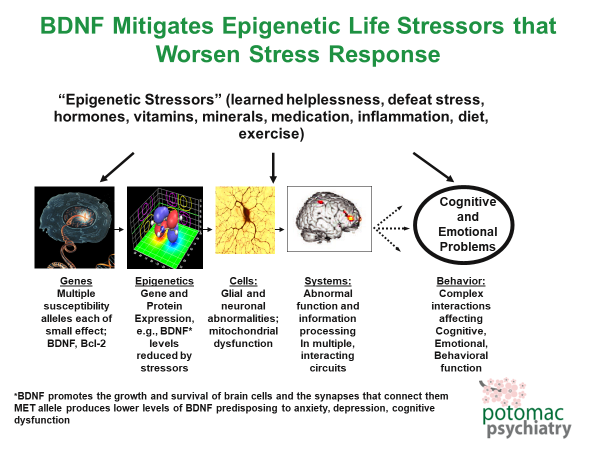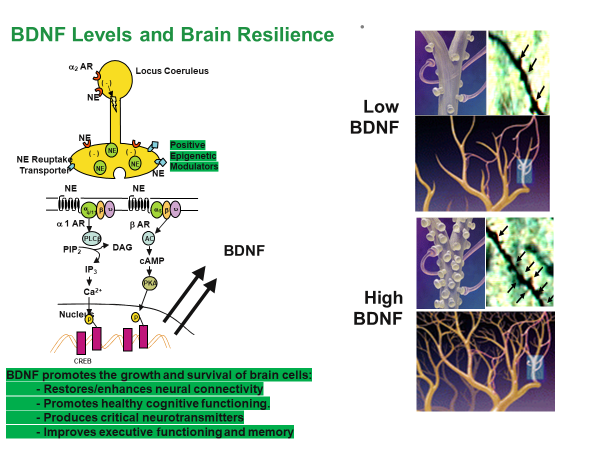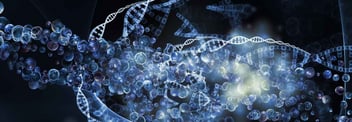DNA: I Am Who I Am… or Am I? – Session Five
- Home
- Blog

The BDNF Gene: Use “Fertilizer” to Grow a Majestic ”Rainforest Brain”… and Introducing “GENiE” and “DNA 4 KIDS”
“Any sufficiently advanced technology is indistinguishable from magic.”
– Arthur C. Clarke
“DNA + Environment + Triggers + Chance = Your Biological Destiny. Grow your brainpower through BDNF, the brain’s “fertilizing protein.”
– Bruce Alan Kehr, M.D.
Would you like to learn how to influence your DNA to grow a brain that is “teaming with life” inside? We’ll get to that shortly, but first allow me to share a story with you. A friend of mine recently had the good fortune of spending a few days deep in the heart of the Borneo jungle—a campsite so remote she had to take a two-hour canoe ride just to get there! I can remember her description so vividly—and the accompanying pictures were visually astonishing. As she slowly left civilization behind, the air became thicker, every breath more rejuvenating. She could see why as she glanced in awe at her wild surrounds: Trees, vines, and flowers dominated the muddy banks of the river, as an overabundance of life multiplied upon itself, and each green leaf exuded life-giving oxygen and promised more with every additional inch of root embedded in the soil. And as her eyes slowly adjusted to the heart of darkness of the rainforest, she saw she was not alone in her enjoyment of each new breath she took—suddenly she could see birds, reptiles, and even monkeys in the trees, all partaking in the exuberance of this special slice of earth where any living thing had a chance to thrive. Over the next few days, she’d absorb even more of this wild slice of our planet… but when I asked her what struck her most about her trip, it wasn’t the beauty, the delicious bounty of food the jungle provided, or even the pleasure of her companions—no, what struck her was the potential that persisted all around her. The potential for such an abundance of life, for new connections and syntheses…. for a natural creativity.
I felt more alive just listening to her stories and looking at her images of a thriving landscape, and was reminded of my numerous journeys deep into the wilds of Patagonia—and yet it was bittersweet, as I thought of all the once-natural places nearby that have been deprived of that potential through over-development. The contrast is stark—and the moral of the story near universal. As humans, I believe we are all inherently partial to landscapes that foster the possibility of life, and are fearful of those scenes that remind us what can happen when we don’t nurture the precious gifts that have been bestowed upon us by nature. But what if I told you that this same stark contrast exists in your own brain? Surely if the contrast was that vivid and tangible, you’d take steps to nurture vibrant life inside of your skull, rather than see it slowly die away. Reader: this week, I have just one simple goal: To make you aware of one particular gene that, if nurtured, allows your very brain structure to flourish, create, and sustain new, amazing potential for your very destiny. This week, we’re talking about one of the most crucial genes within your care: BDNF, the “Brain’s Fertilizer Gene.”
Let me share with you an alternate way I could’ve begun this blog: “Your Brain Derived Neurotrophic Factor (BDNF) promotes both survival and growth of your brain cells and the synapses that connect them, promotes healthy cognitive functioning, produces critical neurotransmitters, and improves executive functioning”. If this is how this post began, I am certain I’d have lost you with this dense, scientific language. In my work as the Whatever It Takes psychiatrist, I believe I have a duty to translate that language into words you not only find comprehensible, but that you find useful and meaningful, so that you can begin to change your own life with a new set of tools. So let me put it this way: this year, we’re talking about DNA, and the many ways in which you can take control of your own destiny through intentional choices that benefit your body and your mind on a biological, genetic level. And perhaps the most important, most fundamental gene in your DNA that you can control is BDNF. With good behavioral and physical habits, you can promote much greater expression of the BDNF gene, which can mean the difference between good and poor memory, weight maintenance or weight gain, a stable mood or depression, and even a quick wit or slowed comprehension.
If you’ve been even vaguely following some of the newspaper headlines for the last decade, you’ve likely seen the news that our brains are more “plastic” than we’ve previously believed—that in fact, with the proper habits, we can nurture our brain and even grow its capacity for potential and creativity. The articles behind this new understanding are helpful—but none of them seem to mention the gene responsible for it all—that’s BDNF. This one gene is the difference between your brain becoming a beautiful, flourishing jungle of potential connections versus atrophying to a state of disuse and helplessness. Why? Because BDNF is the gene responsible for building connections between cells, in order for them to communicate. It’s the gene responsible for building the foundation for neurotransmitters like serotonin and dopamine—critical components of our health, wellbeing and happiness—to function fully. It’s the gene that is responsible for our increased capacity to make intellectual connections—to think on our feet, to draw analogy from past events, to find humor in repetition… all of it. And this precious gene, which accounts for enhancing our brain’s neuroplasticity, is the very gene that helps to keep us mindful and “all there” into our older age. Why wouldn’t we want to protect this precious, life-giving asset! Here are two pictures that dramatically demonstrate my point, and tie in some of my teachings over the past four weeks:


Some of my patients who take the Genecept Assay from Genomind* discover that they have a genetic mutation which makes it difficult for them to naturally produce enough BDNF to maintain a level of flourishing plasticity in their brains. And this is why genetic tests, and understanding your own DNA, becomes so critically important—because as soon as you understand your genetic vulnerabilities, you can begin to modify them to improve your health and well-being. As the first picture above depicts, higher levels of BDNF are instrumental to healthy mood regulation and executive functioning, and are significantly influenced by life stressors, including learned helplessness, defeat stress, hormones, vitamins, minerals, medication, inflammation, diet, and exercise. My patients who have inherited a genetic predisposition for a low level of BDNF, amplified by these stressors, can begin to overcome their negative effects to bring about positive results. Exercise, for instance, has been proven to promote the greater expression of this gene, thereby boosting BDNF levels and multiplying the potential for new and vibrant neuronal connections by an exponential amount. Other positive influencers include an altered diet—for instance following a ketogenic diet. And lithium and other medications also increase BDNF levels.
BDNF is a foundational gene, fertilizing the roots of a grand brain cell ecosystem not dissimilar to a thriving jungle where life can be sustained and grow freely and abundantly. It is our choice, Our Karma, to decide whether we want to foster this gene and grow our own mental jungles—and genetic testing provides us the opportunity to make a well-informed decision.
DNA 4 KIDS with Dr. Mark Novitsky
Hello! My name is GENiE, and I was summoned here by my friends, Dr. Kehr and Dr. Novitsky, to help guide you on a magical journey. Along the way, you will unlock a hidden code inside of you that will teach you how your body works. When you were born, each of your parents passed along to you a special “recipe” – Your DNA – that makes you unique – unlike anyone else in the entire world. I should know, I’ve been around for billions of years and have never seen two people who were exactly the same (even identical twins end up a little bit different). While you can’t change your recipe – the Genes you were born with – I will teach you how to add some ingredients to those genes to boost your health and happiness. Through our journey together, I hope that I can become your friend, too.
GENiE, I wish for… 100 Billion!

Well, your wish is already granted. Your brain has 100 billion nerve cells and several hundred trillion connections… There are many different kinds of nerves in the body, some transmit information to organs and muscles, and other are responsible for making you feel good.
There are things that you can do to make sure these nerves are able to “grow” and become healthy, strong nerves. The GENiE likes to use the comparison of growing crops. What does it take to grow little seedlings into big strong plants? It takes the right balances between seeds, fertilizer, sun, and water. Now picture a farmer living near a lush tropical rain forest. They have the advantage of nutrient rich soil, lots of water, and sunlight. Now compare that to a farmer living in the United States. Both can grow their crops, but it might take a little extra work for the farmer living in the US to harvest healthy plants.
Your parents passed down to you instructions about how your body works through something called genes. One of these genes is for BDNF (Brain Derived Neurotrophic Factor). BDNF’s job is to help the brain grow, just like the nutrient rich fertilizer (“Neurotrophic” is a big word for “Brain-Growth”).
 Some people are lucky enough to have instructions for the tropical rainforest-like environment where they naturally have lots of BDNF. Other people might need a little extra work to help their nerves grow, just like the farmer in the US. The good news is that we know the secret recipe for helping these people to increase the amount of BDNF in their system – Exercise! It might sound a little strange coming from a doctor who prescribes medicines and talks with you about your feelings and problems, but exercise is the BEST way to increase your BDNF (though there are other vitamins and medications that can also be beneficial). Regardless, while exercise is important for every kid to do, the ones who need more BDNF will especially find themselves feeling happier, calmer, and smarter.
Some people are lucky enough to have instructions for the tropical rainforest-like environment where they naturally have lots of BDNF. Other people might need a little extra work to help their nerves grow, just like the farmer in the US. The good news is that we know the secret recipe for helping these people to increase the amount of BDNF in their system – Exercise! It might sound a little strange coming from a doctor who prescribes medicines and talks with you about your feelings and problems, but exercise is the BEST way to increase your BDNF (though there are other vitamins and medications that can also be beneficial). Regardless, while exercise is important for every kid to do, the ones who need more BDNF will especially find themselves feeling happier, calmer, and smarter.
(*Drs. Kehr and Novitsky hold no ownership interest in Genomind)
DNA: I Am Who I Am… or Am I? Blog Series
- Does DNA Determine My Destiny?
- Tinker with Your Genes to Determine Your Destiny
- A Simple Cheek Swab Brings Good Karma
- Test Your DNA to Determine Your Reality
- The BDNF Gene: Use “Fertilizer” to Grow a Majestic ”Rainforest Brain”… and Introducing “GENiE” and “DNA 4 KIDS”
- The MTHFR Gene: “Manufacture” Your Way to Health and Happiness Featuring “DNA 4 KIDS” with “GENiE”
- The SLC6A4 Gene (Serotonin Reuptake Gene): Improve Your Mood and Anxiety through a Simple Cheek Swab Featuring “DNA 4 KIDS” with “GENiE”
- Tame that Emotional Roller Coaster Ride Genetic Testing for the ANK3 Gene and CACNA1C Gene Featuring “DNA 4 KIDS” with “GENiE”
- Is Addiction Inherited? Genetic Testing for the OPRM1 Gene, Opioid Abuse, and Alcoholism Featuring “DNA 4 TEENS” With “GENiE”
- Surf’s Up: Use Your Genetic Code to Ride the Stress Wave with Ease The COMT Gene Featuring “DNA 4 KIDS” With “GENiE”
- Mental Illness is not a Myth—and Human Genomics Proves It The DRD2 Gene and Dopamine Featuring “DNA 4 KIDS” With “GENiE”
- ADHD in the Age of Distraction The Tricky Genetics behind ADHD and ADRA2A Featuring “DNA 4 KIDS” With “GENiE”
- Overweight and Obesity – Is it Me, or My DNA? 5HT2C and MC4R: Can Your Genes Make You Fat?
- Is Alcoholism Inherited? Can a Tiny Gene Help Treat It? The GRIK1 Gene
- 2018 Women’s Health and Wellness Summit DNA Keynote Address
Related Information
- Learn about Genetic Testing
- Learn about Potomac Psychiatry
- Meet Our Doctors
- Contact Potomac Psychiatry
.png?width=144&height=144&name=Untitled%20design%20(34).png)



